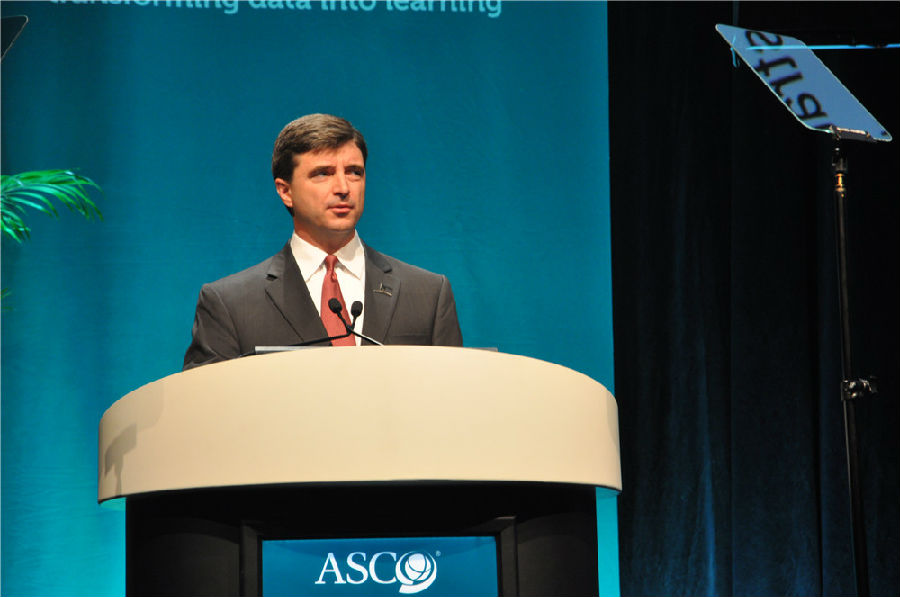医脉通编译整理,转载请务必注明出处。
在芝加哥当地时间5月31日下午举行的ASCO全体大会上,圣朱迪儿童研究医院的Gregory T. Armstrong教授带来的一项分析显示,20世纪70年代以来,医疗的改善延长了儿童癌症生存幸存者的寿命。医脉通对此进行了报道。

Gregory T. Armstrong教授
ASCO专家Stephen Hunger评论说:“几十年以来,我们都在避免儿童癌症幸存者的悖论,即接受治疗只是为了几年后再度染病或死去。通过认真改革儿童癌症治疗方案,长期治疗和护理的结果已经得到了突飞猛进的改善。治愈率的提高也带来了癌症治疗并发症相关死亡率的下降。我们希望我们今天看到的有利趋势将会继续随着治疗方式的进步而持续下去。”
过去的四十余年,大部分儿童癌症的治疗方案的目的都是提高患者生存率,同时减少威胁生命的晚期副反应的发生率,推广幸存者在风险期的随访工作。
纳入人口学和疾病相关资料统计分析了34033例5年存活患者(1970-1999年间诊断的年龄<21岁,中位随访时间21年,范围5-38)的晚期死亡情况,使用累计发生率和泊松回归模型计算相对风险(RR)和95%置信区间。对非复发(NR)/非外部(NE)原因的死亡,其中包括肿瘤治疗晚期副反应相关死亡,进行了统计。
3958例死亡人数中有1622例(41%)为NR/NE原因死亡,其中751例为继发肿瘤(SN),243例为心源性,136例为肺死亡。10年治疗的变化包括急性淋巴细胞白血病颅脑放疗比率的下降(全部,86%、54%、22%),Wilms瘤RT的下降(WT,77%、54%、49%),霍奇金淋巴瘤RT的下降(HL,96%、88%、77%)。ALL、HL、WT治疗近15年观察到的累计NR/NE死亡人数渐少,分别为ALL (p<.001)、HL (p=.005)、WT(p=.005)。 其中心源性死亡率下降分别为ALL(p=.002)、HL(p=.06)、WT (p=.04) ,WT的SN (p<.001)。诊断年度(对年龄、性别、诊断、随访时间进行校正)与所有原因的死亡风险(RR=0.85,CI 0.83-0.87)、NR/ NE死亡风险(RR=0.87,CI 0.84-0.91)、SN死亡风险(RR=0.84,CI 0.80-0.89)、心源性死亡风险(RR=0.78,•CI 0.69-0.87)和肺死亡风险(RR=0.79,CI0.68-0.91)的下降显著相关。
社会保障机构队列提供的证据表明以减少晚期副反应的发生率、提高早期检测率为目的的治疗方案的改进,有效地渐少了晚期死亡率。 [说明]累计死亡发生率(%)为诊断后15年。
会议专题》》》2015年ASCO年会专题报道
摘要原文
Background: Over the past four decades, treatment of many childhood cancers has been modified with the aim of achieving high survival rates while reducing the risk of life-threatening late-effects, and promoting risk-based follow-up care of survivors.
Methods: Late mortality was evaluated in 34,033 5-year survivors (diagnosed < 21 years of age from 1970-1999, median follow-up 21 years, range 5-38) using cumulative incidence and Poisson regression models adjusted for demographic and disease factors to calculate relative risk (RR) and 95% confidence intervals (CI). Mortality due to non-recurrence/non-external (NR/NE) causes, which includes deaths that reflect late-effects of cancer therapy, was evaluated. Results: 1,622 (41%) of the 3,958 deaths were attributable to NR/NE causes, including 751 subsequent neoplasm (SN), 243 cardiac, and 136 pulmonary deaths. Changes in therapy by decade included reduced rates of: cranial radiotherapy (RT) for acute lymphoblastic leukemia (ALL, 86%, 54%, 22%), RT for Wilms tumor (WT, 77%, 54%, 49%) and RT for Hodgkin lymphoma (HL, 96%, 88%, 77%).
Reductions: in 15 year cumulative NR/NE mortality were observed across treatment eras for ALL (p < .001), HL (p = .005), and WT (p = .005). Cardiac deaths decreased in ALL (p = .002), HL (p = .06), and WT (p = .04), and SN deaths decreased in WT (p < .001). Year of diagnosis (adjusted for age, sex, diagnosis, follow-up time) was significantly associated with a reduced risk of all-cause mortality (RR = 0.85, CI 0.83-0.87), NR/NE death (RR = 0.87, CI 0.84-0.91), death from SN (RR = 0.84, CI 0.80-0.89), cardiac death (RR = 0.78, CI 0.69-0.87) and pulmonary death (RR = 0.79, CI 0.68-0.91).
Conclusions: The CCSS cohort provides evidence that the strategy of modifying therapy to reduce the occurrence of late-effects, and promotion of early detection, is successfully translating into a significant reduction in observed late mortality. [caption]Cumulative incidence (%) of death at 15 years from diagnosis.
